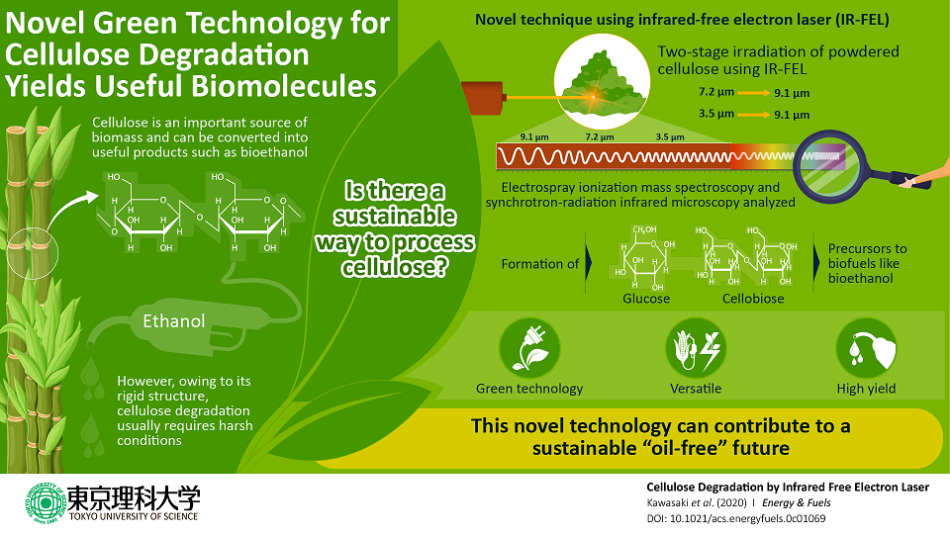Jun 24 2020
On the global scale, the most abundant form of biomass found is a plant product known as cellulose. It can be transformed into useful products like biofuels.
 A novel laser-based strategy for the effective degradation of cellulose into useful products. Image Credit: Tokyo University of Science.
A novel laser-based strategy for the effective degradation of cellulose into useful products. Image Credit: Tokyo University of Science.
However, the processing of this biopolymer is complicated due to its firm, water-insoluble structure.
Researchers from Japan have designed a new laser-based method that makes degradation of cellulose simpler. This reaction does not need drastic conditions, and thus can support efficient cellulose application in several industries, particularly environmental technology.
Finding efficient alternatives to fossil fuels is crucial since there is an impending risk of climate crisis.
One choice is to make use of clean sources of fuels known as biofuels, which can be generated from natural sources like biomass. Globally, the plant-based polymer cellulose is the most abundant form of biomass and can be transformed into raw materials like xylose and glucose to produce bioethanol, which is a kind of biofuel.
However, this process is difficult because of the molecule’s dense and rigid structure, which makes it insoluble in water. Biotechnologists and chemists across the globe have utilized traditional methods such as hydrolysis, ultrasonication, and microwave radiation to degrade this polymer. However, such processes need severe conditions and are hence unsustainable.
To overcome this challenge, in a new study published in the Energy & Fuels journal, a research group from Japan, which includes Dr Takayasu Kawasaki (Tokyo University of Science), Dr Heishun Zen (Institute of Advanced Energy, Kyoto University), professor Yasushi Hayakawa (Laboratory of Electron Beam Research and Application, Institute of Quantum Science, Nihon University), professor Toshiaki Ohta (SR Center, Ritsumeikan University), and Professor Koichi Tsukiyama (Tokyo University of Science), has designed a novel method for the degradation of cellulose.
This method is based on a kind of laser known as the infrared-free electron laser (IR-FEL), with a wavelength that can be tuned in the range of 3 to 20 μm. This new technique seems to be a potential green technology for the zero-emission degradation of cellulose.
One of the unique features of the IR-FEL is that it can induce a multiphoton absorption for a molecule and can modify the structure of a substance. So far, this technology has been used in the basic fields of physics, chemistry, and medicine, but we wanted to use it to spur advances in environmental technology.
Dr Takayasu Kawasaki, Researcher, Infrared Free Electron Laser Research Center, Tokyo University of Science
The researchers were aware that it is possible to use IR-FEL to carry out dissociation reactions on several biomolecules. Cellulose is a biopolymer made up of hydrogen, oxygen, and carbon molecules, which form covalent bonds of diverse angles and lengths with each other.
The polymer features three infrared bands at the wavelengths of 3.5 μm, 7.2 μm, and 9.1 corresponding to three distinct bonds: the C−H stretching mode, H−C−O bending mode, and the C−O stretching mode, respectively.
Depending on these modes, the researchers irradiated powdered cellulose by adjusting the wavelength of the IR-FEL to the three wavelengths.
Subsequently, they examined the products with the help of methods like synchrotron radiation infrared microscopy and electrospray ionization mass spectrometry, which showed that the cellulose molecules have been degraded into glucose and cellobiose (precursor molecules used for bioethanol production).
Moreover, their products were achieved at high yields, rendering the process highly efficient.
This was the first method in the world to efficiently obtain glucose from cellulose by using an IR-FEL. Because this method does not require harsh reaction conditions such as harmful organic solvents, high temperature, and high pressure, it is superior to other conventional methods.
Dr Takayasu Kawasaki, Researcher, Infrared Free Electron Laser Research Center, Tokyo University of Science
Besides producing biofuels, cellulose finds various applications—for instance, as hybrid paper materials, antibacterial sheets, and functional biomaterials in biocompatible cell membranes.
Therefore, the new technique developed in this study exhibits the potential to be used for various sectors, like engineering, technology, and healthcare. Furthermore, Dr Kawasaki believes that the new technique can be useful in processing not just cellulose but also other wood constituents, and thus prove to be a novel technique for recycling forest biomass.
We hope that this study will contribute to the development of an ‘oil-free’ society.
Dr Takayasu Kawasaki, Researcher, Infrared Free Electron Laser Research Center, Tokyo University of Science
Journal Reference:
Kawasaki, T., et al. (2020) Cellulose Degradation by Infrared Free Electron Laser. Energy & Fuels. doi.org/10.1021/acs.energyfuels.0c01069.